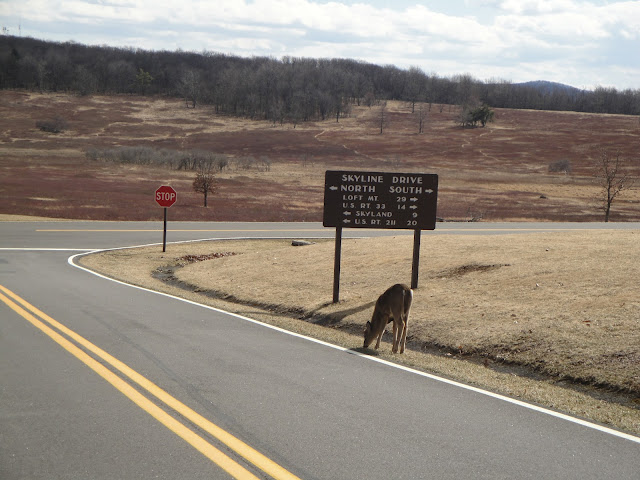It was easy to combine two events from my guidebook into one trip, and given the driving distance involved it seemed like common sense to do so. Among the events not chosen for March were: rare gulls, tundra swans, and "accidental" species. That last one refers primarily to birds whose migratory senses have failed and sent them to who-knows-where. The phrase "primarily to birds" reminds me to point out my one disappointment with this book so far: it leans quite heavily to birding. So far 11 of the 15 suggested activities have focused on avian life. I have no aversion to bird-watching, but I had hoped for a bit more diversity. It looks like the ratio gets a little better in April, but a "guide to the natural year" whose April section excludes morel hunting seems like sacrilege.
March Events: Endangered Fox Squirrels and Migrating Ducks and Geese
This double-dip was made possible by the proximity of two "hotspots" to one another. I thought that either target individually might be difficult to spot, so the freedom to do both in one trip seemed like a prime opportunity to raise the odds of success. I was pretty enthusiastic about this trip from early March when I started planning it, because it offered two separate chances to see species that are a bit outside the norm. It disappointed me when one thing after another caused the trip to be pushed back, but I was determined to continue with this twelve-month project.
 |
| Aside from the stuffed specimen, this was pretty much the only evidence of fox squirrels, although there is a third example to be mentioned later. |
Seeing Delmarva Fox Squirrels was an exciting prospect, because they're a) endangered, b) adorable, and c) enormous compared to other squirrels. The visitor center at one of our destinations had a taxidermied example, and so at least I know what one of these beasts looks like.
The rare gulls were something of a longshot anyway, especially since we were late. The migratory season for these birds starts at the beginning of March, and while stragglers are always possible several weeks later, April 1st was a bit of a stretch.
The Location
This trip took us first to Blackwater National Wildlife Refuge, and then to Wye Island Natural Resources Management Area. The former does not allow pets (outside of vehicles, anyway) but is a beatiful drive. There are several short hikes available in Blackwater, and they are short enough that leaving a small companion (say, for example, a beagle-basset mix) in the car is perfectly safe and acceptable. This doesn't mean your small companion will like it. The latter is beautiful as well, but also pet-friendly. Wye Island NRMA offers about a half-dozen short-to-medium length hikes, of which we did two. Since Wye Island is directly on our way back from Blackwater, combining these two destinations into one outing was extremely easy.
Why there, and Why then?
Delmarva fox squirrels at Wye Island:
 This squirrel has a limited habitat range to begin with - it can only be found on the Delmarva Peninsula. Within this already small area, the squirrel has been eliminated from most places. Wye Island is a pocket of woods that still has everything necessary for a fox squirrel population; Blackwater also has some such areas, as does Eastern Neck NWR. March is a good month for seeking them because their activity increases as their winter food stores begin to run dry. As I understand squirrel behavior in general, they are not hibernators but do spend most of the winter in their dens.
This squirrel has a limited habitat range to begin with - it can only be found on the Delmarva Peninsula. Within this already small area, the squirrel has been eliminated from most places. Wye Island is a pocket of woods that still has everything necessary for a fox squirrel population; Blackwater also has some such areas, as does Eastern Neck NWR. March is a good month for seeking them because their activity increases as their winter food stores begin to run dry. As I understand squirrel behavior in general, they are not hibernators but do spend most of the winter in their dens.Migrating ducks and geese at Blackwater:
In this case the timing is the key. Migrating birds are directed by the lengthening days int he Spring, and so their journeys can be predicted with some accuracy after a few years of observation. Three species of geese, almost thirty species of duck, and tundra swans migrate through the Eastern mid-Atlantic every March. For several weeks, spots like Blackwater NWR provide havens for these birds on their journey between their two regular habitats (some, of course, stay in the region and can be seen more or less all year). Many, however, can only be seen in this general area during their migrations.
The Trip, and What I Learned
 |
| A turkey vulture |
 |
| jack-in-the-pulpit |
I learned a lot about the Delmarva fox squirrel, although very little about the ducks and geese we also didn't see. I have also resolved to take the word "endangered" more seriously. Our squirrel technically is only a subspecies of the fox squirrel, Sciurus niger; however, I understand there are those who contest that it deserves its own species (one can imagine Monty Python shouting "Splitter!" in anger). It is much larger than the common gray squirrels DC residents are familiar with, and has lighter fur with a white underbelly. In terms of behavior, it spends more time on the ground and prefers a higher canopy than its urbanized cousin. It is most active early in the morning, which I think contributed to our failure. I believe that the many species of fowl we had hoped to find were already gone; by now they are likely well-settled in their summer homes. We returned home from this trip having missed our objectives, but feeling nonetheless fulfilled by the beauty of nature.






























